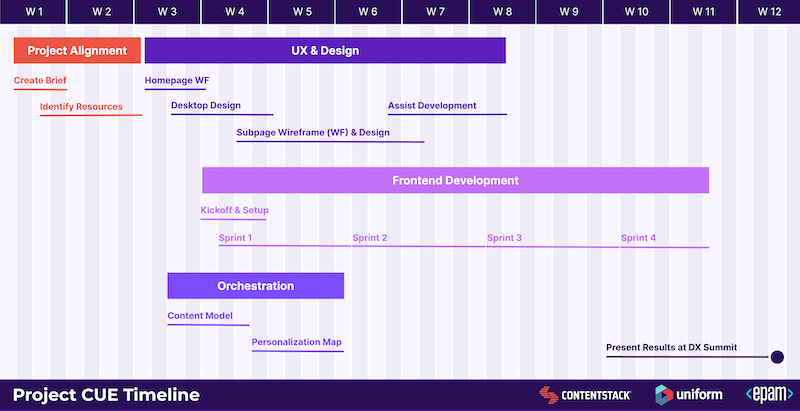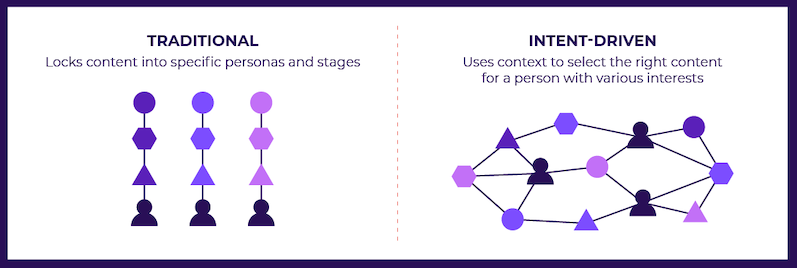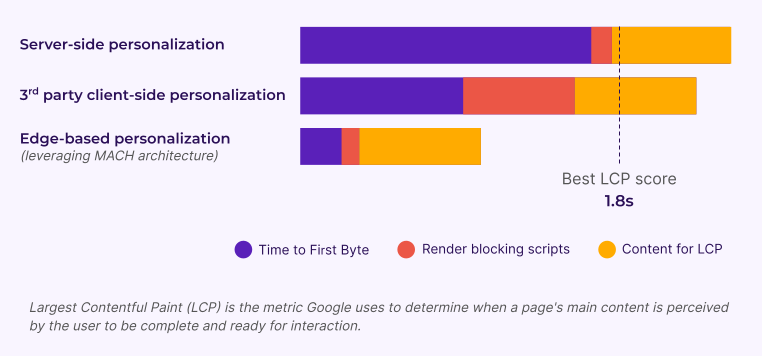Personalization is tough. So tough, in fact, that Gartner predicts 80% of marketers will abandon their personalization efforts by 2025.
That’s why we set out to prove there’s now a practical path to omnichannel personalization that’s powered by best-in-class enterprise tools. To demonstrate what’s possible with this modern approach, Contentstack, Uniform, and EPAM teamed up to launch Project CUE, an agile personalization showcase.
In just 12 weeks, the Project CUE team created a personalized booking experience for guests of a fictional Las Vegas resort that offers entertainment and dining packages alongside a visitor’s stay. As part of the personalized experience for “Balbianello resort,” web and mobile content adapts to real-time visitor behavior, such as browsing events, clicking on marketing emails, or taking a quiz. When booking tickets or a table, the guest list can be added to recommend additional events that match party size, schedule, and available guest preferences, as well as to ensure everyone has access to a personal itinerary of bookings and travel information.
With a modern approach to personalization, a lot can happen in three months.
How We Did It: Flexible Tools for Efficient Teams
Using Contentstack’s headless content management, Uniform’s personalization engine, and EPAM’s design and development expertise, the Project CUE team was able to show that empowering developers and businesses teams with easy-to-use tools offers a fast-track to personalization.

MACH Architecture
A MACH approach to digital architecture (microservice-based, API-first, cloud-native, headless) is key to modern personalization. MACH tools are designed to support a composable enterprise where every component is pluggable, scalable, replaceable, and can be continuously improved to meet evolving business needs.
The composability of Contentstack and Uniform allowed the team to leverage quick starts for both solutions and get a functioning website up and running in the first week of development sprints. This ease of integration, made possible by MACH architecture, lets companies create proof of concept projects with minimal resources that can be quickly iterated on and scaled up as value is proven.
Parallel Work
Project CUE relied on a team that spanned three companies and multiple time zones, so tools needed to be highly collaborative and ensure global team members could move at full speed.
The modularity of MACH technologies allows teams to build and manage different experience components in parallel, meaning projects are no longer held up by a waterfall of dependencies.
For Project CUE, this meant that content creators could map content personalization, designers could create wireframes, and developers could work on the frontend simultaneously and check in once a week to update everyone on progress.

For a more in-depth look at the collaboration involved, check out the development and architecture overview or watch the full Project CUE session presented at DX Summit.
Intuitive Personalization
For personalization to be practical, it shouldn't require a PhD in rules to work. Uniform and Contentstack integrate to let marketers create content and intuitively manage personalization from the same place. Simple metadata tags can be added to each piece of content to map it to visitor interests, with the ability to add and remove tags easily as the strategy evolves.
Instead of locking visitors into a single persona, Uniform’s personalization engine uses real-time behavior to identify the current intent a visitor has, such as “booking tickets to a show” or “finding gourmet dining”, and uses the metadata tags to surface the right pieces of content in the right context.

What It Proves: High-performing Experience on Any Channel
For personalization to drive results, speed is not only critical for time to market but also for content delivery. Both Contentstack and Uniform are built for enterprise scale and demands, ensuring a high performing experience across every touchpoint.
Headless Content
Contentstack decouples content from its presentation (i.e., its head) and stores content as modular blocks that can be created once and delivered to any channel via APIs. This API-first approach delivers content quickly, since it’s not weighed down by frontend code, and the ability to update individual blocks of content without having to reload the entire page enables highly efficient personalization.
Edge-based Personalization
Uniform uses a globally distributed content delivery network (CDN) to move personalization as close to the user as possible, as opposed to having to continuously call back to a central server. Personalization happens client-side, using data such as device characteristics, location, and visitor behavior to identify a visitor’s intent and adapt content in real-time.
Unlike third-party personalization tools that rely on render-blocking scripts to work, Uniform runs with minimal Javascript to cut content delivery time well below industry benchmarks such as Google’s Core Web Vitals.

Progressive Web App
One way that Project CUE leverages the joint power of Contentstack and Uniform is with a PWA for the mobile experience. Visitors get the look and feel of an app from the convenience of a mobile browser, with content and personalization data seamlessly shared between web and mobile.
Where to Start: A Practical Approach to Personalization
The flexibility of MACH tools means that companies can start implementing personalization without needing to rip and replace their current technology landscape. Teams can start experimenting with personalization in one part of the experience, such as a microsite, a specific brand, or a certain stage of the customer journey and use those successes to gain momentum and scale personalization across the business.
To learn more about jumpstarting agile personalization in your organization, check out our recent solution brief for the 3 new rules of personalization.
